BUICK ROADMASTER 1993 Owners Manual
Manufacturer: BUICK, Model Year: 1993, Model line: ROADMASTER, Model: BUICK ROADMASTER 1993Pages: 340, PDF Size: 18.34 MB
Page 271 of 340
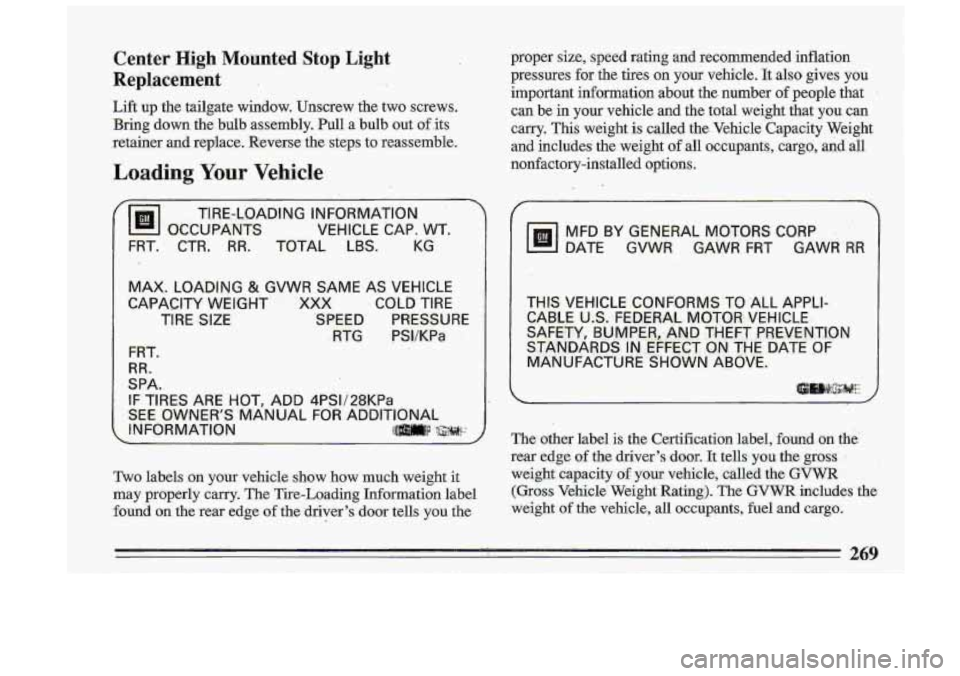
Center High Mounted Stop Light
Replacement
Lift up the tailgate window. Unscrew the two screws. Bring down the bulb assembly. Pull a bulb out of.its
retainer and replace. Reverse the,steps to reassemble.
Loading Your Vehi.cIe
proper size, speed rating and recommended inflation
pressures for the tires
on your vehicle. It also gives you
important information about the number
of people that
can be in your vehicle and the total weight that you can
carry.
This weight is called the Vehicle Capacity Weight
and includes the weight of
all occupants, cargo, and all
nonfactory-installed options.
@I OCCUPAN'TS TIRE-LOADING
INF0,RMATlON
.
V:EHICLE CAP, WT.
FRT.. CTR. RR. TOTAL LBS. KG
1
MAX. LOADING & GVWR SAME AS VEHICLE
CAPACITY
WEIGHT XXX COLD TIRE
TIRE SIZE
SPEED PRESSURE
.RTG PSI/KPa
FRT.
RR.
SPA.
IF TIRES ARE HOT, ADD 4PSI/28KPa
SEE OWNER'S 'MANUAL FOR ADDITIONAL
INF0,RMATlON
ll]mp ,$$$#/:::
Two labels on your vehicle show how much weight it
may properly carry. The Tire-Loading Information label
found -on- the rear edge of the driver's door tells you the
Y
MFD BY GENER-At MOTORS CORP
DATE GVWR GAWR FRT GAWR
RR
THIS VEHICLE CONFORMS TO 'ALL APPLI- CABLE US. FE,DE.RAL MOT0.R'
VEH'ICLE
SAFETY, BU.MPER,-AND THiEFT PREVENTI0.N
STANDARD,S IN EFFECT ON THE DATE
OF
MANUFACTURE SHOWN ABOVE.
~i~,l\i$;~!~~!~
The other label is the Certification 'label, found on the'
rear edge of the driver's do,ar. It tells you the gross
weight capacity
of your vehicle, called the GVWR
(Gross Vehicle' Weight Rating). The GVWX includes the.
weight of the vehicle, all occupants, fuel and cargo.
269
Page 272 of 340
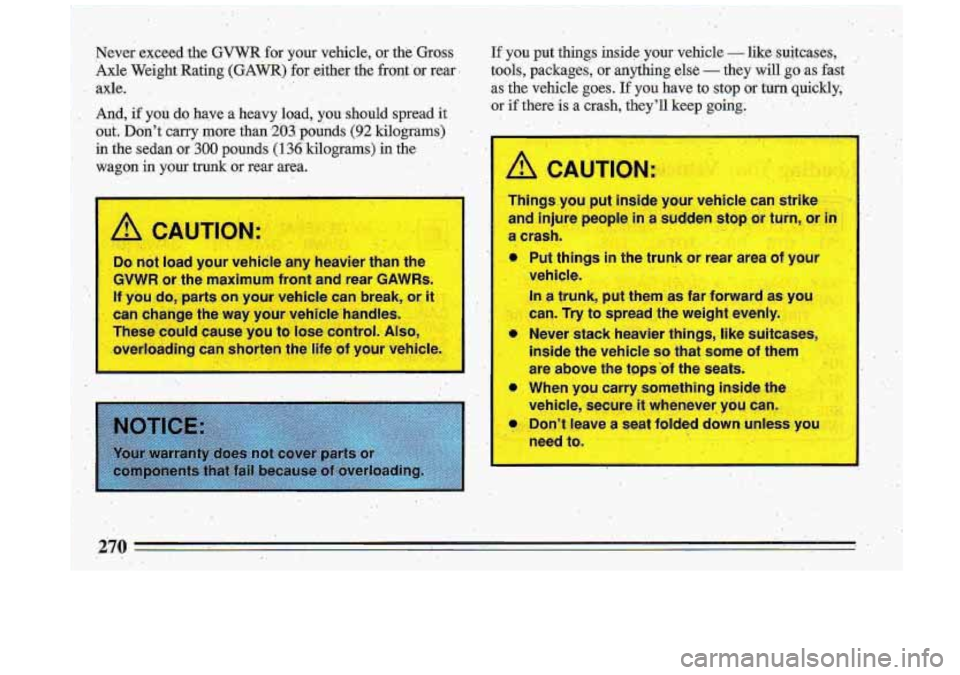
Never exceed the GVWR for.your vehicle, or the"Gross If you put things inside your vehicle - like.suitcases, .,
Axle Weight Rating (GAWR) for ,either the front 'or rear. tools, packages, or anything else - they will go ,as fast '
I -. axle.. as 'the
vehicle goes. If you have to stop or turn quickly,
, And, if you do have a heavy load, you-should spread it
1 . out. Don't 'carry more than.2'03 pounds (92 kilograms)
. wagon in your trunk or rear area. '8
or if.there is a crash, they'll keep goirig. I.
.. .
in the sedan or 300 pounds (136 kilograms-) in the m - .1
: II
A CAUTION:
i I)
Do not load your vehicle any heavier than the
GVWR or the maximum front and rear GAWRs. I
If you do, parts on your vehicle can break, or it
can change the way your vehicle handles.
These could'cause you to lose control.
Also,
.overloadina can shorten the li of vow vehic
(!a CAUTIO1
Things.y Jt inside your vehicle can 'ikt
and injure people in a sudden stop or tuln lr i~
a crash.
the trunk or rear area of your
0 Put things
vehicle.
In a trunk, put.thern'as far forward as vou
can. Try to spread the weight evenly,
* Never stack heavier things, like suitcas,,
inside the vehicle
so that some sf them
are above the tops'of the seats.
When you carry somet,hing inside
thd
vehicle, secure it whenever. you can.
9 Don't lei-? a seat folded down unless yo1
need to.
I
Page 273 of 340
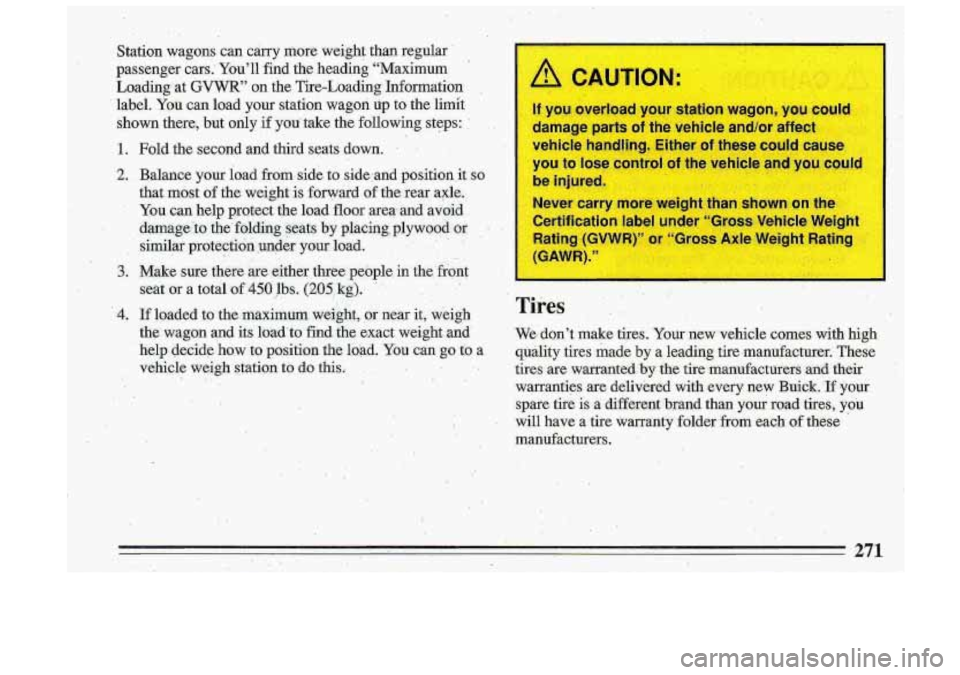
,I
Station wagons can carry more weight than regular
passenger cars:- You’ll find ,the heading-“Maximum
Loadingat
GVWR” on the Tire-Loading- Information
labei.
YQU can load your station wagon up to the limit
shown there, but only if
you’ take the following steps: ;
1.
2.
3.
-4.
.. ..
I
IT you swerloaa your somon wagon, you CQI
damage parts of the vehicle and/or affect
vehicle handling. Either of these could cau!
you
to 10s- --1trol of the vehicle and you c-~d
be injured
Newer carry rn ht than the
Certification label under “Gross Vehicle Weight
r ‘‘Gross Axle Weight Rating
..
Tires ..
We, don’t make tires. Your new vehicle comes with high
quality tires made by a leading tire,manufacturer. These
tires are
warranted.:by the tire manufacturers and their :
warranties are delivixed with every new Buick. :If your
spare ti& is a different brand than yo& road tires,. you
will have a tire warranty folder fi-om eaGh of these
manufacturers.
I
271
Page 274 of 340
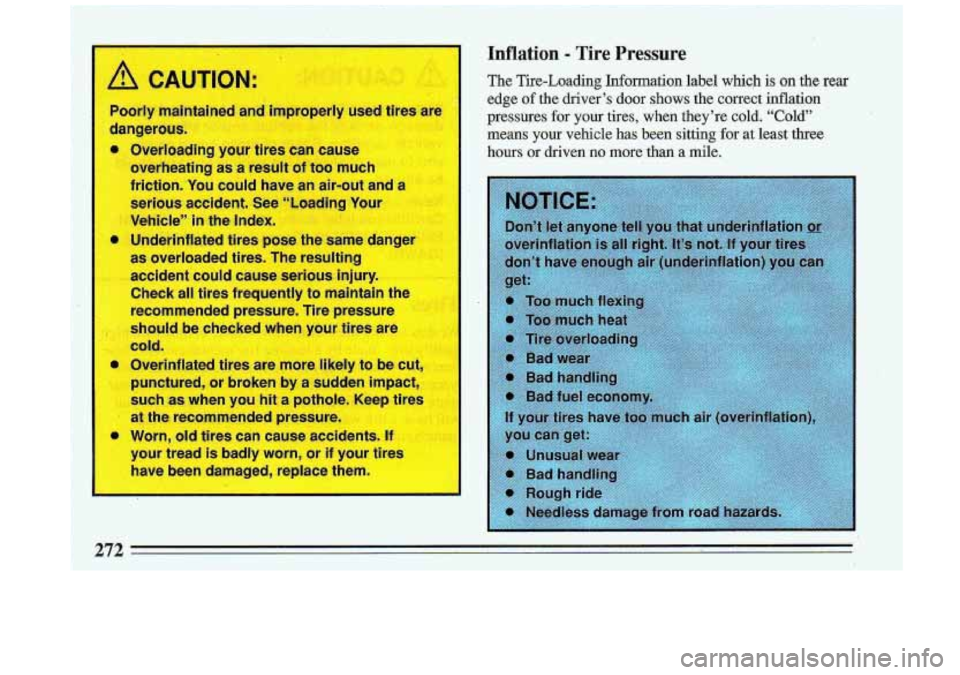
ION
)orly maintained and improper1
dangerous.
Overloading
- 3ur tires can caus [sed
tires are
e
overheating as a result
of too much
friction:You could have an air-out ant
serisws accident. See -“Loading Your
Vehicle”
in the Inde:
Underinflated tires
pose the same dangc
as overloaded tires. The resulting
accident’could cause serious injury.
Check
all tires frequently to maintain a I
recommended pressure. Tire pressure
sha I be checked when your tires are
cold
Overinflated tires are more likely to be cut,
punctured, or broken
by a sudden impact,
such as when
you hit a pothole. Keep tires
at the recommended pressure
Worn, old tires can cause accidents.
I,
your tread is badly worn, or if your tires
have been damaged, replace them.
Inflation - Tire Pressure
The Tire-Loading Information label which is on the rear
edge of the driver’s door shows the correct inflation
pressures
for your tires, when they’re cold. “Cold”
means your vehicle
has been sitting for at least three
hours or driven no more than a mile.
Page 275 of 340
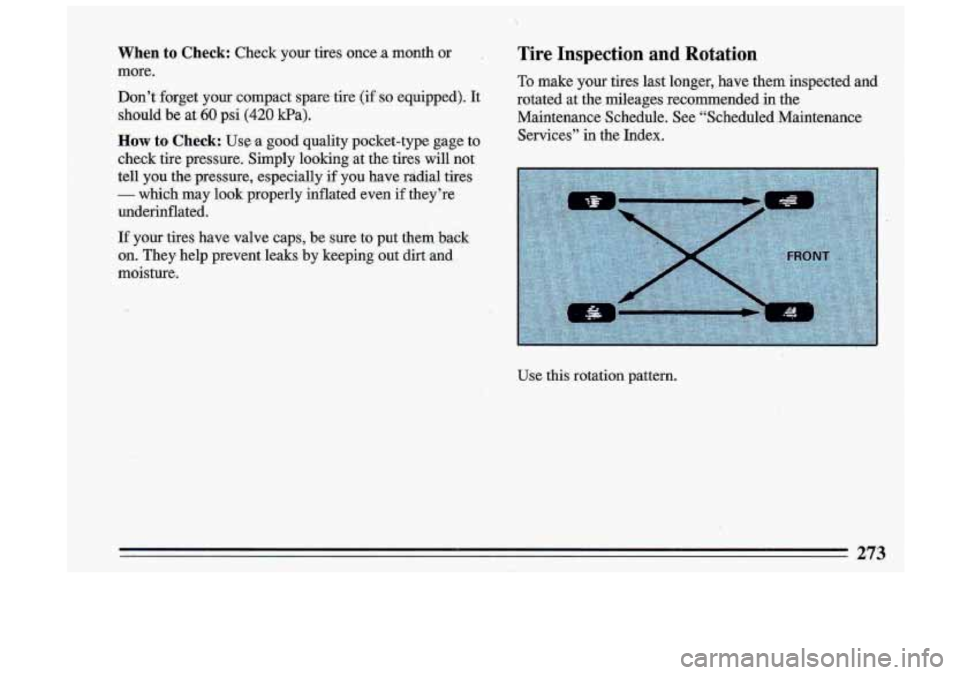
When to Check: Check your tires once .a month or
more.
Don’t forget
your compact spare-tire (if SO equipped). It
should be at 60 psi (420 Pa).
How to Check: Use a good quality pocket-type gage to
check tire pressure. Simply looking at the tires will not
tell you the pressure, especially if
you have radial tires
- which may look properly inflated even if they’re
underinflated.
If your tires have valve caps, be sure to put them back
.on. They help prevent leaks by keeping
out dirt and
moisture.
Tire Inspection and Rotation
To make your tires last longer, have them inspected and
rotated at the mileages recommended in the, Maintenance Schedule. See “Scheduled Maintenance Services”
in the Index.
Use this rotation pattern.
t
273
Page 276 of 340
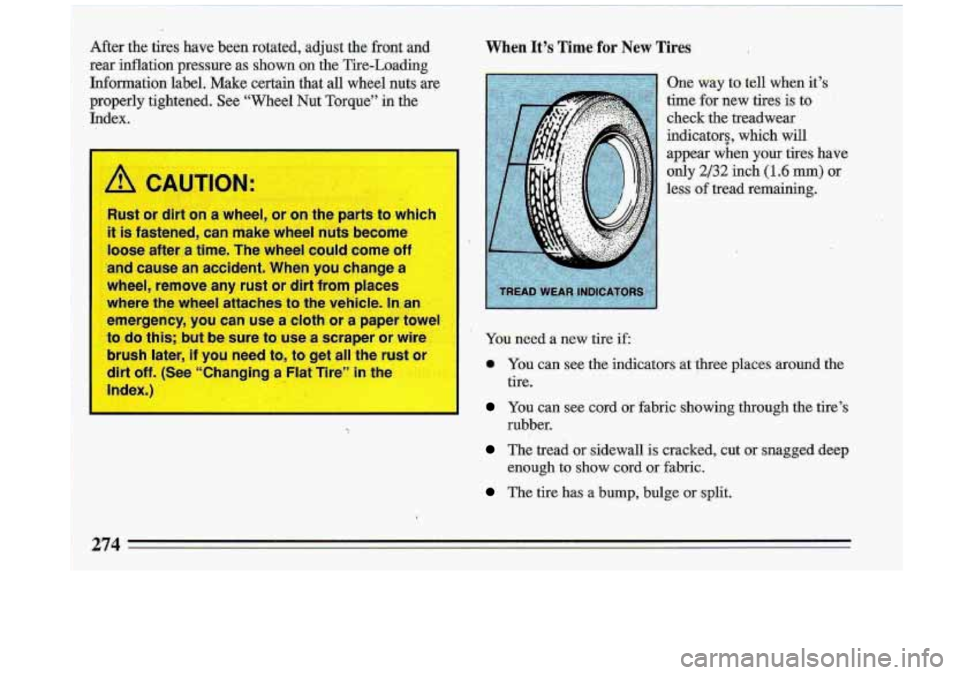
After the tires have beers rotated, adjust the front and
rea inflation pressure as shown on the Tire-Loading
Information label. Make certain that all wheel nuts ax9
properly tightened. See “Wheel Nut Torque” in the
’ ..
Index.
A CAUTION:
Rust or diir on a wheel, or on the parts to which
it is fastened, can make wheel nuts become
loose after a time. The wheel-could come off
‘and cause an accident. When you change a
wheel, remove any rust or dirt from places
where the wheel attaches to the vehicle.
In an
emergency, you can use a’cloth or a paper towel
to
do this; but be sure to use a scraper or wire
brush later,
if you need to, to get all the rust --
dirt off. (See “Changing a Flat Tire” in the
Index.)
I
When It’s Time for New Tires
One way to tell when it’s
time for new tires
is to.
check the treadwear’-
*. ’
indicators, which will
appear when your tires have only
2/32 inch (1.6 mm) or
less of tread remaining.
I
I
.’
DU need a new tire if
You can see the indicators at three places around the
tire.
You can see cord or fabric showing through the tire’s
The tread or sidewall is cracked, cut -or snagged deep
rubber.
enough to show cord or fabric.
The tire has a bump, bulge or .split.
274
Page 277 of 340
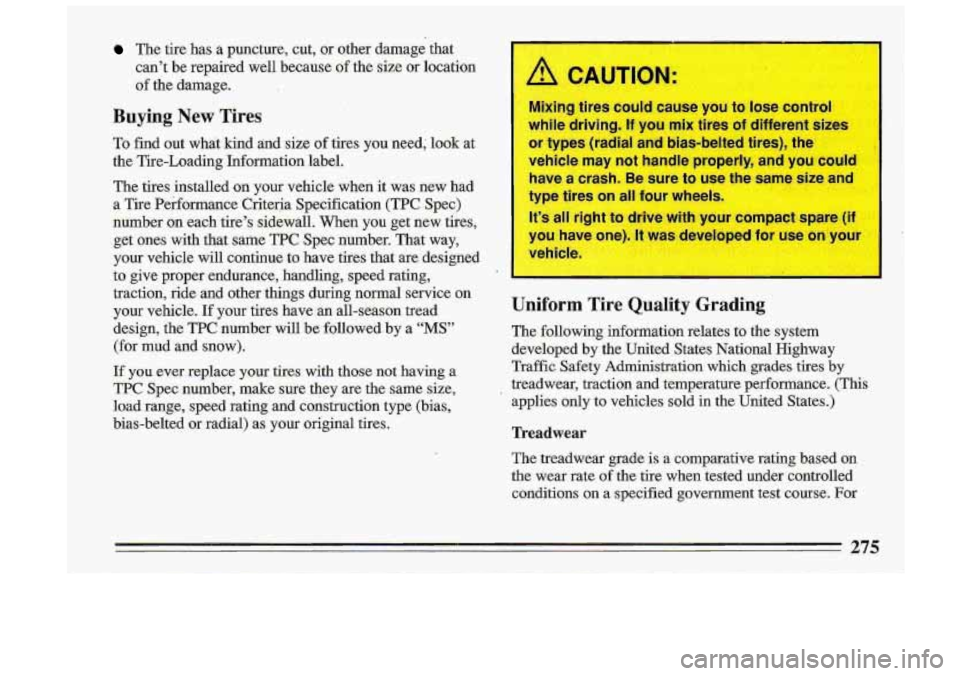
The tire has a puncture, cut, or other damage that
can’t be repaired well because of the size or location
of the damage.
Buying New Tires
.To find out what kind and size of tires you need; look at
the Tire-Loading Information label.
The tires installed on your vehicle when it was new had
a Tire Performance Criteria Specification
(TPC Spec)
-number on each tire’s sidewall. When you get new tires, get ones with that same TPC Spec number.
That way,
your vehicle will continue
to have tires that are designed
to give proper endurance, handling, speed rating,
traction, ride and other things during normal service on
your vehicle.
If your tires have an all-season tread
design, the
TPC nu-mber will be followed. by a “MS”
(for mad and snow).
If you ever replace your tires with those not having a
TPC Spec number, make sure .they are the same size,
load range, speed rating and construction type (bias,
bias-belted or radial) as your original tires.
‘t
A CAUTION:
Mixing tires could cause you to lose control
while driving. If you mix tires of different siz
or types (radial and bias-belted tires), the
vehicle may not handle properly, and you
cows
have a crash. Be sure to use the same size and
type tires
on all four wheels.
It’s all right to drive with your compact spare (if
you have one). It
was developed for use on your
I
I
‘ :le.
Uniform Tire Quality Grading
The following information relates to the system
developed by the United States National Highway
Traffic Safety Administration which grades tires
by
treadwear, traction and temperature performance. (This
applies only to vehicles sold
in the United States.)
Treadwear
The treadwear grade is a comparative rating based on
the wear rate of the tire when tested under controlled
conditions
on a specified govement test course. For
I
Page 278 of 340
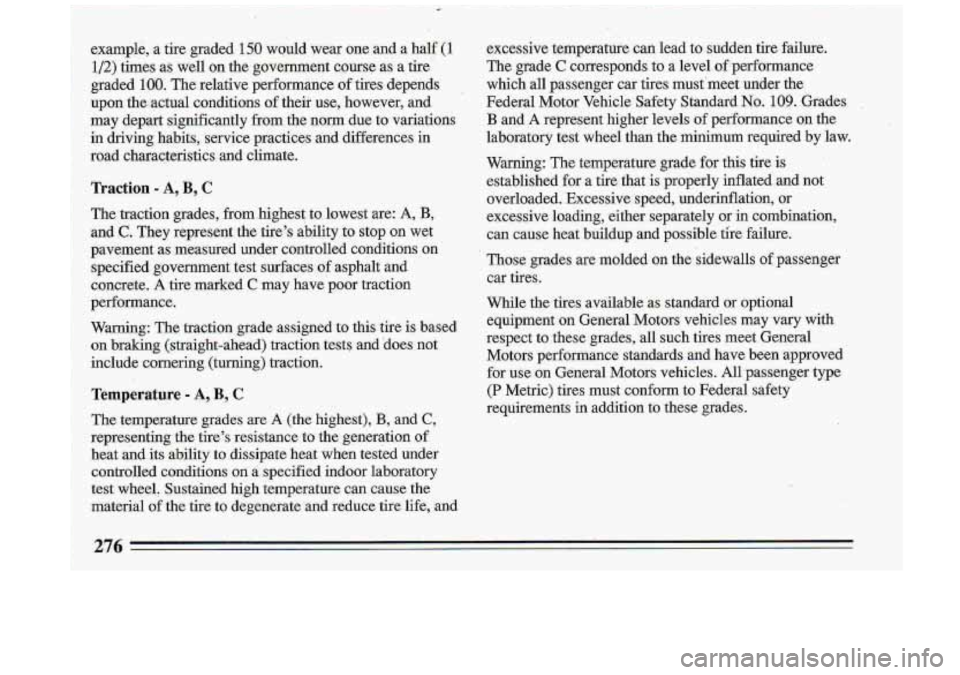
.276
Page 279 of 340
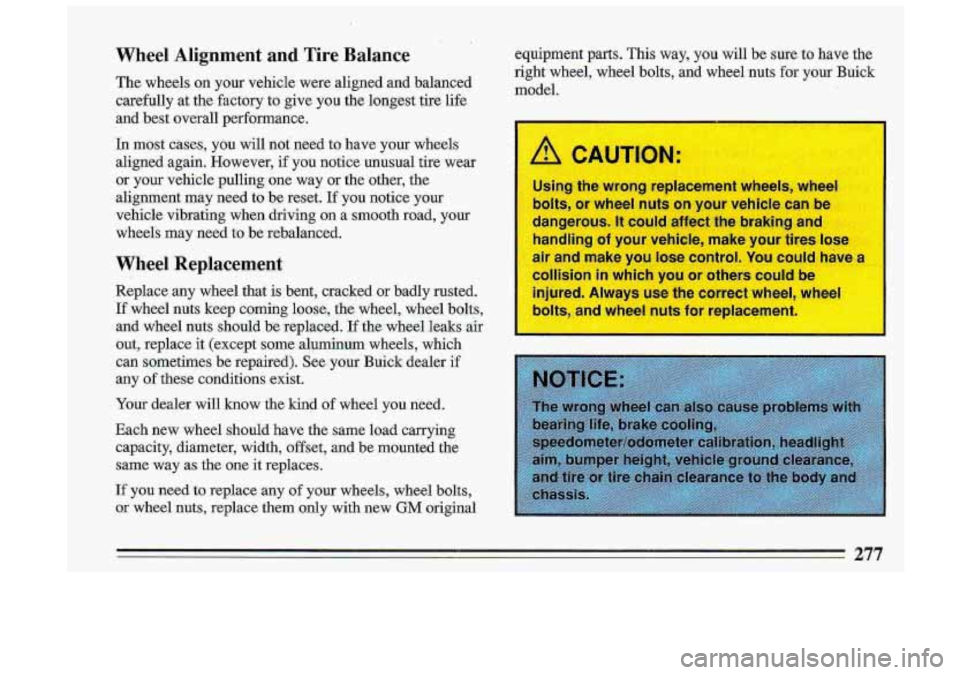
Wheel Alignment and Tire Balance
The wheels on your vehicle were aligned and balanced
carefully at the factory to give you the longest tire life
and best overall performance.
In most cases, you will not'need to have your wheels
aligned again. However, if
you notice unusual tire wear
or your vehicle pulling one way
or the other, the
alignment may need to be reset.
If you notice your
vehicle vibrating when driving
on a smooth road, your
wheels may need to be rebalanced.
Wheel Replacement
Replace any wheel that is bent, cracked .I or badly rusted.
If wheel nuts keep coming loose, the wheel, wheel bolts,
and wheel nuts should be replaced.
If the wheel leaks air
out, replace it (except some aluminum wheels, which
can sometimes be repaired). See. your Buick dealer
if
any of these conditions exist.
Your dealer will how the kind
of wheel you need.
Each new wheel should have the same load carrying capacity, diameter, width, offset, and be mounted the
same way as the one it replaces.
If you need to replace-any of your wheels, wheel bolts,
or wheel nuts, replace them only with new
GM original equipment parts. This
way,
you will be sure to have the
right wheel, wheel bolts, and wheel
nuts for your Buick
model.
/! CA-TION:
Using the wrong replacement wheels, wheel
bolts, or wheel nuts on your vehicle can be
dangerous.
It could affect the braking and
handling of your vehicle, make your tires lose
air and make you lose control.
You could ,have a
collision in which you or others could
I !
bolts, and wheel nuts for reelacement. jured. Always use the correct wheel,
whec
I
.. ~ ~
277
Page 280 of 340
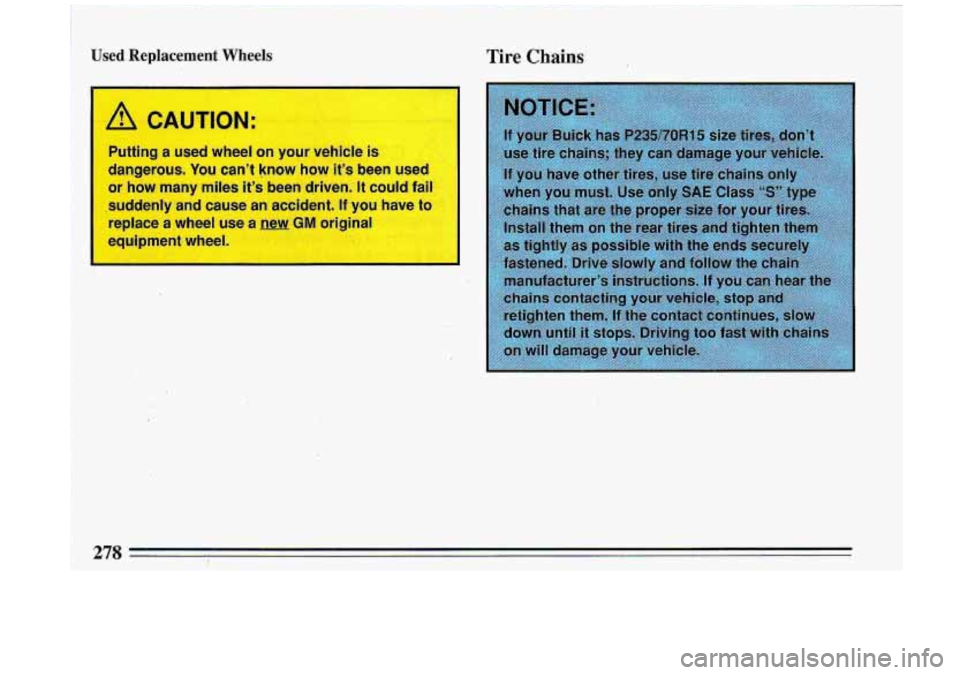
Putting a used wheel on your vehicle is
dangerous. You can't know how it's been used
or how many miles it's been driven.
It could fail
suddenly and cause an accident.
If you have to
replace a wheel u
equipment wheel.
Tire Chains
278